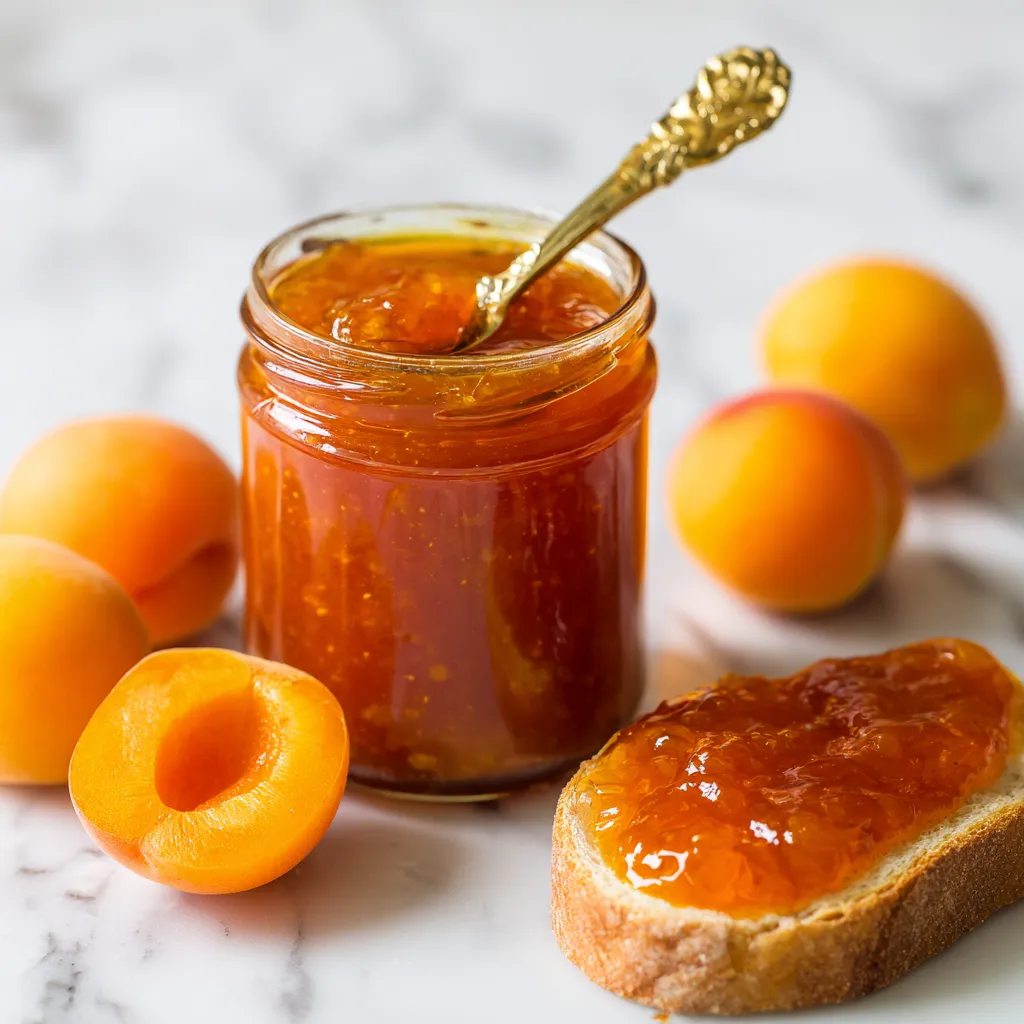 Save
Save
This classic apricot jam recipe captures summer’s best fruit at its juiciest peak and lets you enjoy all that sunshine flavor long after the season has gone. It is an easy and traditional preserve that transforms only three ingredients into jars of golden goodness for breakfast toast or desserts.
I first learned to make this jam with my grandmother using fruit from our own backyard tree and even now the scent of simmering apricots fills me with nostalgia and pride.
Ingredients
- Fresh apricots: Quality fruit is essential Pick apricots that are perfectly ripe without bruises or dark spots slightly firm is good
- Granulated sugar: Classic for jam it sweetens preserves and helps the jam set Look for fine cane sugar with sparkling crystals
- Lemon juice: Adds brightness and helps the jam set naturally Use freshly squeezed lemons for best results
- Water: Just a hint loosens the fruit to begin with Make sure it is clean and fresh
Step-by-Step Instructions
- Sterilise the Jars:
- Begin by choosing sparkling clean glass jars with tight fitting lids Free from cracks and chips is best Wash them well by hand or in the dishwasher then set both jars and lids on a baking tray and heat in a low oven for at least twenty minutes to kill off any bacteria or spoilage risk
- Prepare the Apricots:
- Wash the apricots gently and pat dry Remove any blemishes Slice them in half and remove the stones Weigh out the prepared fruit so you have the correct amount
- Start Cooking the Fruit:
- Place the apricot halves into a large wide saucepan Pour the water and lemon juice over Stir to mix Place the saucepan on the stove and bring to a simmer over medium heat Stir occasionally as the fruit softens Cover and cook until apricots are tender usually about ten to fifteen minutes
- Blend or Leave Chunky:
- If you prefer a smoother jam allow the fruit to cool slightly and blend with a hand blender right in the pot For those who love rustic jam just leave it as is
- Add the Sugar:
- Tip in all the sugar Stir the mixture with a long wooden spoon without letting it boil yet Keep stirring until the sugar completely dissolves This step is crucial for a smooth set
- Boil to Thicken:
- Raise the heat and bring everything to a rapid boil Stir every so often to prevent scorching As the mixture thickens and reduces stir more frequently and skim off any foam that rises The jam needs your attention now
- Test for Setting Point:
- After boiling for about twenty minutes take a little jam and place it on a cold plate from your freezer Let it cool for a minute then push your finger through If the jam wrinkles and holds its shape it is ready If still runny boil a bit longer and check again
- Jar the Jam:
- Let the jam settle in the pot for ten minutes so fruit pieces distribute evenly Carefully ladle the piping hot jam into the hot sterilised jars using a funnel if possible Fill each jar to the top and seal with sterilised lids
- Cool and Store:
- Allow the jars to cool at room temperature then wipe clean and label Store them in a cool dark spot for up to one year Opened jars should live in the fridge and always use a clean dry spoon to serve
 Save
Save
Every summer I look forward to visiting the orchard where I first tasted apricots warm from the sun It is still my favorite moment when the first jar of jam is opened in winter and the taste brings back all those memories
Storage Tips
Once the jam jars are sealed and cooled keep them in a cool pantry or cupboard away from light For best flavor and shelf life check your jars for leaks or cracks Jam stays fresh for about a year but always store opened jars in the fridge and finish within two months
Ingredient Substitutions
While nothing beats the taste of peak season apricots you can include a handful of peaches or plums for a flavor twist Always use fruit that is just ripe but not mushy Bottled lemon juice works in a pinch but fresh makes a big difference in taste and helps the jam set better
Serving Suggestions
Apricot jam is wonderful spread on warm toast scones or croissants It is also perfect as a glaze for cakes grilled chicken or added to yogurt and cheese boards A spoonful stirred into salad dressing adds a sweet tangy depth
The Story of Apricot Jam
Homemade jams like this are a tradition in many cultures often made in big family gatherings when the stone fruit bounty arrives The bright color and pure fruit flavor always remind me of summers past Each batch made by hand feels like a gift to your future self
Recipe FAQs
- → How do I know when the jam has set?
Test by placing a spoonful on a chilled plate and running your finger through it—if it wrinkles slightly, it's ready.
- → Why use lemon juice with apricots?
Lemon juice balances sweetness and encourages natural pectin to set the preserve properly.
- → Can I use less sugar?
Sugar acts as both sweetener and preservative. Reducing it risks spoiling and affects consistency, so it's not recommended.
- → How should I sterilise jars?
Wash jars and lids well, then heat them in a 130°C (270°F) oven for at least 20 minutes before filling.
- → How long does homemade apricot preserve keep?
Properly sealed and stored jars in a cool, dark place can last up to a year. Refrigerate after opening.
- → Do I need to add pectin?
No, apricots contain enough natural pectin when combined with lemon juice for setting the preserve.
